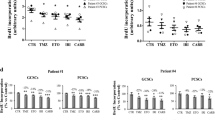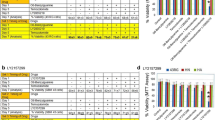Abstract
The IDH mutation initially exhibits chemosensitive properties, progression-free survival cannot be achieved in the later grades, and malignant transformation occurs as a result of TMZ-induced hypermutation profile and adaptation to this profile. In this study, we evaluated the potential of the combination of TMZ and AZD7762 at molecular level, to increase the anticancer activity of TMZ in IDH-mutant U87-mg cells. We used the WST-1 test to evaluate cytotoxic effect of TMZ and AZD7762 combination with dose–effect and isobologram curves. The effects of the inhibitory and effective concentrations of the combination on apoptosis, cell cycle and γ-H2AX phosphorylation were analyzed with flow cytometry. The expression of genes responsible for the DNA damage response was analyzed with qRT-PCR. The combination showed a synergistic effect with high dose reduction index. Single and combined administrations of TMZ and AZD7762 increased in G2/M arrest from 24 to 48 h, and cells in the G2/M phase shifted towards octaploidy at 72 h. While no double-strand breaks were detected after TMZ treatment, AZD7762 and combination treatments caused a significant increase in γ-H2AX phosphorylation and increased apoptotic stimulation towards 72 h although TMZ did not cause apoptotic effect in IDH-mutant U87-mg cells. The genes controlling the apoptosis were determined to be upregulated in all three groups, and genes regarding cell cycle checkpoints were downregulated. Targeting Chk1/2 with AZD7762 simultaneously with TMZ may be a potential therapeutic strategy for both increasing the sensitivity of IDH-mutant glioma cells to TMZ and reducing the dose of TMZ.
Graphical abstract
In IDH-mutant glioma cells, AZD7762, the Chk1/2 inhibitor, can increase the efficacy of Temozolomide by (i) increasing mitotic chaos, and (ii) inhibiting double-strand break repair, (iii) thereby inducing cell death.







Similar content being viewed by others

References
Cohen AL, Holmen SL, Colman H. IDH1 and IDH2 mutations in gliomas. Curr Neurol Neurosci Rep. 2013;13:345.
Han S, Liu Y, Cai SJ, Qian M, Ding J, Larion M, et al. IDH mutation in glioma: molecular mechanisms and potential therapeutic targets. Br J Cancer. 2020;122:1580–9.
Kayabolen A, Yilmaz E, Bagci-Onder T. IDH mutations in glioma: double-edged sword in clinical applications? Biomedicines. 2021;9(7):799.
Zhang J, Stevens M, Bradshaw T. Temozolomide: mechanisms of action, repair and resistance. Curr Mol Pharmacol. 2012;5:102–14.
Yoshimoto K, Mizoguchi M, Hata N, Murata H, Hatae R, Amano T, et al. Complex DNA repair pathways as possible therapeutic targets to overcome temozolomide resistance in glioblastoma. Front Oncol. 2012;2:186.
Roos WP, Batista LFZ, Naumann SC, Wick W, Weller M, Menck CFM, et al. Apoptosis in malignant glioma cells triggered by the temozolomide-induced DNA lesion O6-methylguanine. Oncogene. 2006;26:186–97.
Fuchs RP, Isogawa A, Paulo JA, Onizuka K, Takahashi T, Amunugama R, et al. Crosstalk between repair pathways elicits double-strand breaks in alkylated dna and implications for the action of temozolomide. Elife. 2021;10: e69544.
Annovazzi L, Mellai M, Schiffer D. Chemotherapeutic drugs: DNA damage and repair in glioblastoma. Cancers. 2017;9(6):57.
Eich M, Roos P, Nikolova T, Kaina B. Contribution of ATM and ATR to the resistance of glioblastoma and malignant melanoma cells to the methylating anticancer drug temozolomide. Mol Cancer Ther. 2013;12(11):2529–40.
Annovazzi L, Caldera V, Mellai M, Riganti C, Battaglia L, Chirio D, et al. The DNA damage/repair cascade in glioblastoma cell lines after chemotherapeutic agent treatment. Int J Oncol. 2015;46:2299–308.
Leonardi R, Subramanian C, Jackowski S, Rock CO. Cancer-associated isocitrate dehydrogenase mutations inactivate NADPH-dependent reductive carboxylation. J Biol Chem. 2012;287:14615.
Del Alcazar CRG, Todorova PK, Habib AA, Mukherjee B, Burma S. Augmented HR repair mediates acquired-temozolomide resistance in glioblastoma. Mol Cancer Res. 2016;14:928.
Itamochi H, Nishimura M, Oumi N, Kato M, Oishi T, Shimada M, et al. Checkpoint kinase inhibitor AZD7762 overcomes cisplatin resistance in clear cell carcinoma of the ovary. Int J Gynecol Cancer. 2014;24:61–9.
Wang L, Wang Y, Chen A, Jalali A, Liu S, Guo Y, et al. Effects of a checkpoint kinase inhibitor, AZD7762, on tumor suppression and bone remodeling. Int J Oncol. 2018;53:1001–12.
Zhu J, Zou H, Yu W, Huang Y, Liu B, Li T, et al. Checkpoint kinase inhibitor AZD7762 enhance cisplatin-induced apoptosis in osteosarcoma cells. Cancer Cell Int. 2019;19:1–11.
Isono M, Hoffmann MJ, Pinkerneil M, Sato A, Michaelis M, Cinatl J, et al. Checkpoint kinase inhibitor AZD7762 strongly sensitises urothelial carcinoma cells to gemcitabine. J Exp Clin Cancer Res. 2017;36:1–12.
Abe H, Natsumeda M, Kanemaru Y, Watanabe J, Tsukamoto Y, Okada M, et al. MGMT expression contributes to temozolomide resistance in H3K27M-mutant diffuse midline gliomas and MGMT silencing to temozolomide sensitivity in IDH-mutant gliomas. Neurol Med Chir (Tokyo). 2018;58:290.
Yu Y, Villanueva-Meyer J, Grimmer MR, Hilz S, Solomon DA, Choi S, et al. Temozolomide-induced hypermutation is associated with distant recurrence and reduced survival after high-grade transformation of low-grade IDH-mutant gliomas. Neuro Oncol. 2021;23(11):1872–84.
Aasland D, Götzinger L, Hauck L, Berte N, Meyer J, Effenberger M, et al. Temozolomide induces senescence and repression of DNA repair pathways in glioblastoma cells via activation of ATR–CHK1, p21, and NF-κB. Cancer Res. 2019;79:99–113.
Langerak P, Russell P. Regulatory networks integrating cell cycle control with DNA damage checkpoints and double-strand break repair. Philos Trans R Soc B. 2011;366:3562–71.
Filippi-Chiela EC, Thomé MP, Bueno e Silva MM, Pelegrini AL, Ledur PF, Garicochea B, et al. Resveratrol abrogates the Temozolomide-induced G2 arrest leading to mitotic catastrophe and reinforces the Temozolomide-induced senescence in glioma cells. BMC Cancer 2013;13:1–13.
Li GM. Mechanisms and functions of DNA mismatch repair. Cell Res. 2007;18:85–98.
Sun X, Turcan S. From laboratory studies to clinical trials: temozolomide use in IDH-mutant gliomas. Cells. 2021;10:1225.
Hirose Y, Berger MS, Pieper RO. Abrogation of the Chk1-mediated G2 checkpoint pathway potentiates temozolomide-induced toxicity in a p53-independent manner in human glioblastoma cells. Cancer Res. 2001;61:5843–9.
Stepanenko AA, Andreieva SV, Korets KV, Mykytenko DO, Baklaushev VP, Huleyuk NL, et al. Temozolomide promotes genomic and phenotypic changes in glioblastoma cells. Cancer Cell Int. 2016;16:1–16.
Bian L, Meng Y, Zhang M, Li D. MRE11-RAD50-NBS1 complex alterations and DNA damage response: implications for cancer treatment. Mol Cancer. 2019;18:1–14.
Roos WP, Nikolova T, Quiros S, Naumann SC, Kiedron O, Zdzienicka MZ, et al. Brca2/Xrcc2 dependent HR, but not NHEJ, is required for protection against O6-methylguanine triggered apoptosis, DSBs and chromosomal aberrations by a process leading to SCEs. DNA Repair (Amst). 2009;8:72–86.
Wang H-H, Chang T-Y, Lin W-C, Wei K-C, Shin J-W. GADD45A plays a protective role against temozolomide treatment in glioblastoma cells. Sci Rep. 2017;7:1–15.
Jin S, Mazzacurati L, Zhu X, Tong T, Song Y, Shujuan S, et al. Gadd45a contributes to p53 stabilization in response to DNA damage. Oncogene. 2003;22:8536–40.
Maeda T, Hanna AN, Sim AB, Chua PP, Chong MT, Tron VA. GADD45 regulates G2/M arrest, DNA repair, and cell death in keratinocytes following ultraviolet exposure. J Invest Dermatol. 2002;119:22–6.
Liu K, Zheng M, Lu R, Du J, Zhao Q, Li Z, et al. The role of CDC25C in cell cycle regulation and clinical cancer therapy: a systematic review. Cancer Cell Int. 2020;20:1–16.
Tsai SF, Tao M, Ho LI, Chiou TW, Lin SZ, Su HL, et al. Isochaihulactone-induced DDIT3 causes ER stress-PERK independent apoptosis in glioblastoma multiforme cells. Oncotarget. 2017;8:4051.
Urist M, Tanaka T, Poyurovsky MV, Prives C. p73 induction after DNA damage is regulated by checkpoint kinases Chk1 and Chk2. Genes Dev. 2004;18:3041.
Mao Z, Bozzella M, Seluanov A, Gorbunova V. Comparison of nonhomologous end joining and homologous recombination in human cells. DNA Repair (Amst). 2008;7:1765.
Lin L, Cai J, Tan Z, Meng X, Li R, Li Y, et al. Mutant IDH1 enhances temozolomide sensitivity via regulation of the ATM/CHK2 pathway in glioma. Cancer Res Treat. 2021;53:367.
Iliakis G, Wang Y, Guan J, Wang H. DNA damage checkpoint control in cells exposed to ionizing radiation. Oncogene. 2003;22:5834–47.
Castedo M, Perfettini JL, Roumier T, Yakushijin K, Horne D, Medema R, et al. The cell cycle checkpoint kinase Chk2 is a negative regulator of mitotic catastrophe. Oncogene. 2004;23:4353–61.
Liao H, Ji F, Helleday T, Ying S. Mechanisms for stalled replication fork stabilization: new targets for synthetic lethality strategies in cancer treatments. EMBO Rep. 2018;19: e46263.
Krishnan V, Tay LS, Ito Y. The fanconi anemia pathway of DNA repair and human cancer. Adv DNA Repair 2015
Syljuåsen RG, Sørensen CS, Hansen LT, Fugger K, Lundin C, Johansson F, et al. Inhibition of human Chk1 causes increased initiation of DNA replication, phosphorylation of ATR targets, and DNA breakage. Mol Cell Biol. 2005;25:3553.
Zhang Y, Lai J, Du Z, Gao J, Yang S, Gorityala S, et al. Targeting radioresistant breast cancer cells by single agent CHK1 inhibitor via enhancing replication stress. Oncotarget. 2016;7:34688.
Roos WP, Frohnapfel L, Quiros S, Ringel F, Kaina B. XRCC3 contributes to temozolomide resistance of glioblastoma cells by promoting DNA double-strand break repair. Cancer Lett. 2018;424:119–26.
Mcneely S, Conti C, Sheikh T, Patel H, Zabludoff S, Pommier YG, et al. Cell Cycle Chk1 inhibition after replicative stress activates a double strand break response mediated by ATM and DNA-dependent protein kinase. Cell Cycle. 2010;9(5):995–1004.
Landau HJ, McNeely SC, Nair JS, Comenzo RL, Asai T, Friedman H, et al. The checkpoint kinase inhibitor AZD7762 potentiates chemotherapy-induced apoptosis of p53-mutated multiple myeloma cells. Mol Cancer Ther. 2012;11:1781–8.
Lu X, Nannenga B, Donehower LA. PPM1D dephosphorylates Chk1 and p53 and abrogates cell cycle checkpoints. Genes Dev. 2005;19:1162.
Podhorecka M, Skladanowski A, Bozko P. H2AX phosphorylation: ıts role in DNA damage response and cancer therapy. J Nucleic Acids 2010
Abe T, Ishiai M, Hosono Y, Yoshimura A, Tada S, Adachi N, et al. KU70/80, DNA-PKcs, and Artemis are essential for the rapid induction of apoptosis after massive DSB formation. Cell Signal. 2008;20:1978–85.
Chou WC, Wang HC, Wong FH, Ding SL, Wu PE, Shieh SY, et al. Chk2-dependent phosphorylation of XRCC1 in the DNA damage response promotes base excision repair. EMBO J. 2008;27:3140.
Yan S, Sorrell M, Berman Z. Functional interplay between ATM/ATR-mediated DNA damage response and DNA repair pathways in oxidative stress. Cell Mol Life Sci. 2014;71:3951.
Karmakar P, Balajee AS, Natarajan AT. Analysis of repair and PCNA complex formation induced by ionizing radiation in human fibroblast cell lines. Mutagenesis. 2001;16:225–32.
Acknowledgements
This study was supported by Ege University Scientific Research Projects Coordination with ID number "20840".
Funding
Funding was provided by Ege Üniversitesi (20840).
Author information
Authors and Affiliations
Contributions
Funding acquisition: EO, methodology/validation/visualization/software/investigation: FS, project administration/supervision: CBA, EO, roles/writing—original draft: FS, CBA.
Corresponding author
Ethics declarations
Conflict of interest
The authors have no relevant financial or non-financial interests to disclose.
Additional information
Publisher's Note
Springer Nature remains neutral with regard to jurisdictional claims in published maps and institutional affiliations.
Supplementary Information
Below is the link to the electronic supplementary material.
Rights and permissions
About this article
Cite this article
Ozgiray, E., Sogutlu, F. & Biray Avci, C. Chk1/2 inhibitor AZD7762 enhances the susceptibility of IDH-mutant brain cancer cells to temozolomide. Med Oncol 39, 166 (2022). https://doi.org/10.1007/s12032-022-01769-x
Received:
Accepted:
Published:
DOI: https://doi.org/10.1007/s12032-022-01769-x



